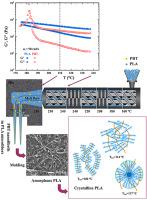Polymer ( IF 4.6 ) Pub Date : 2020-09-17 , DOI: 10.1016/j.polymer.2020.123040 Mahboobeh Shahnooshi , Azizeh Javadi , Hossein Nazockdast , Katharina Ottermann , Volker Altstädt

|
The key rheological parameters for in situ development of poly (butylene terephthalate) nanofibrils (PBT NFs) in poly (lactic acid) (PLA) matrix using a tuned melt spinning process were studied. Observation of ellipsoidal PBT domains oriented along a short die was attributed to a low interfacial tension between the blend constituents and fulfilled melt rheological criteria for fibrillation in a simple shear flow. The stability of the deformed droplets under the shear and elongational flows was studied by comparing the droplet breakup time and residence time in each flow field. It was demonstrated that the deformed droplets (ellipses) with an increased robust interface underwent coalescence through pinch-off in the subsequent elongational flow field, and transformed to the nanofibrils with an average diameter comparable to the gyration radius (Rg) of PLA chains. In the fabricated isotropic in situ nanofibrillar composites (NFCs), a random orientation of 2D nanohybrid shish-kebab (NHSK) superstructure was observed as a result of the orthogonal pattern of melt crystallized PLA nanodomains on the PBT NFs surface. The NHSK superstructure established in quiescent bulk through mechanism of geometric confinement (soft epitaxy) enabled us to tailor the crystalline morphology via annealing temperature. In a constant nanofibril content, increasing the isothermal temperature (Tiso) up to 114 °C led to an increase in the kebabs length and interlocking of the adjacent superstructures. A transition to spherulitic crystal morphology was observed due to further temperature increase (Tiso≥117 °C). The observed transition indicated that at higher Tiso, the fewer raw nuclei, which were initiated by soft epitaxy mechanism of PLA chain segments on the PBT NFs at the early stage of nucleation, could conduct self-nucleation and 3D lateral growth. The Avrami model was found to be applicable for interpreting variations of crystallite morphology, crystallization rate, and nucleation mechanisms with PBT NF content and isotherm temperature.
中文翻译:

流变学合理的原位纳米原纤维结构发展:聚乳酸晶相的纳米混合羊肉串上层结构的定制。
研究了使用调谐熔体纺丝工艺原位开发聚乳酸(PLA)基质中聚对苯二甲酸丁二醇酯纳米原纤维(PBT NFs)的关键流变参数。观察到沿短模具定向的椭圆形PBT域的原因是共混物成分之间的界面张力低,并且在简单的剪切流中满足原纤化的熔体流变学标准。通过比较液滴在各个流场中的破裂时间和停留时间,研究了剪切流和伸长流作用下变形液滴的稳定性。结果表明,变形的液滴(椭圆形)具有增强的坚固界面,在随后的伸长流场中通过夹断进行了聚结,并转化为平均直径与回转半径相当的纳米纤维(Rg)PLA链。在制备的各向同性的原位纳米原纤复合材料(NFC)中,由于PBT NFs表面上熔融结晶的PLA纳米域的正交图案,观察到了2D纳米杂化烤肉串(NHSK)上层结构的随机取向。通过几何约束(软外延)机制在静态主体中建立的NHSK超结构使我们能够通过退火温度来调整晶体形态。在恒定的纳米原纤维含量下,将等温温度(T iso)升高至114°C会导致烤肉串长度的增加和相邻上部结构的互锁。由于温度的进一步升高,观察到向球晶形态的转变(T iso≥117°C)。观察到的过渡表明,在较高的T iso下,由成核初期的PBT NFs上PLA链段的软外延机制引发的原始核较少,可以进行自成核和3D横向生长。发现Avrami模型适用于解释PBT NF含量和等温线温度的微晶形态,结晶速率和成核机理的变化。



























 京公网安备 11010802027423号
京公网安备 11010802027423号